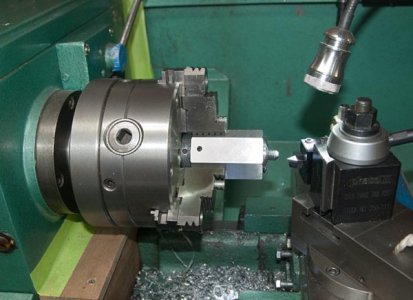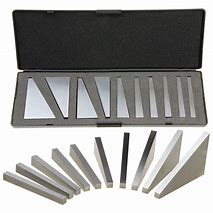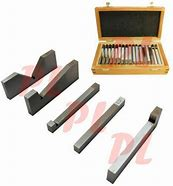- Joined
- Nov 14, 2016
- Messages
- 3,289
I've had my eye on picking up a set of collet blocks since I found out what they are. I spent several hours today looking at 5C collets, collet blocks and spin indexers.
On a whim I also checked eBay and found some ER32 collet blocks. Since I already have a set of ER32 collets, that seemed the most cost effective route, at least for the moment. The pair cost me less than even a modestly priced 5C set with 1/16" spacing, and far less than a comprehensive 1/32 or 1/64 spaced set.
I am left with some questions and since longer term I expect I will be revisiting the idea of 5C collets I might as well ask now while the questions are fresh. I have already spent quite a lot of time searching this site as well as finding threads elsewhere that google turned up. Surprisingly I didn't find any that really went over these in any depth. Mostly touched on through other questions.
It does appear that the 5C collets have the advantage of allowing larger diameter and longer stock to pass through them compared to the ER style. Also some odd shapes available beyond round which I suppose could be useful. On the downside they seem to have very little range for adjustment, so require a fairly large collection or buying very specific sizes based on need.
On the collet blocks, other than the mentioned potential to allow larger stock to pass through, the 5C seems to fit within the block a bit better. I don't expect any serious issues, but the ER blocks I ordered do have a large ring at the front due to the chuck which will somewhat limit how it fits into the vice.
On the other hand since the back end of the ER blocks are clear of any locking mechanism it seems like I should be able to mount the block vertically or horizontally. The 5C blocks I looked at have locking levers at the back which could perhaps be an issue for vertical mounting.
Square blocks seem pretty straight forward, squares, rectangles and right angles.
If I'm thinking correctly a Hex block can do a hex or by skipping sides also an equilateral triangle, possibly other triangles?
There don't seem to be any other shapes but square and hexagon. No Pentagon or Octagon? These seem like fairly common shapes. Not nearly as common as hex nuts but there are pentagonal nuts out there. The stem nut on a fire hydrant being a very common one.
I'm not coming up with a lot for octagons except for stop signs, and old rifle barrels and some iron bars. Actually I guess you could use a square block in a V block holder? Seems like an actual Octagonal block would be easier though.
Last I come to the spin indexer. It doesn't appear that this does anything that couldn't also be done with a rotary table. A spin indexer does seem like it might be easier to use for some tasks and there are plenty of cheap ones around $50 and even presumably higher quality ones are only around $200.
It does appear than they are only offered for 5C collets, but I did find someone offering a 5C - ER32 adapter, so maybe I don't have any need for 5C collets until I find a need to hold something other than round stock.
On a whim I also checked eBay and found some ER32 collet blocks. Since I already have a set of ER32 collets, that seemed the most cost effective route, at least for the moment. The pair cost me less than even a modestly priced 5C set with 1/16" spacing, and far less than a comprehensive 1/32 or 1/64 spaced set.
I am left with some questions and since longer term I expect I will be revisiting the idea of 5C collets I might as well ask now while the questions are fresh. I have already spent quite a lot of time searching this site as well as finding threads elsewhere that google turned up. Surprisingly I didn't find any that really went over these in any depth. Mostly touched on through other questions.
It does appear that the 5C collets have the advantage of allowing larger diameter and longer stock to pass through them compared to the ER style. Also some odd shapes available beyond round which I suppose could be useful. On the downside they seem to have very little range for adjustment, so require a fairly large collection or buying very specific sizes based on need.
On the collet blocks, other than the mentioned potential to allow larger stock to pass through, the 5C seems to fit within the block a bit better. I don't expect any serious issues, but the ER blocks I ordered do have a large ring at the front due to the chuck which will somewhat limit how it fits into the vice.
On the other hand since the back end of the ER blocks are clear of any locking mechanism it seems like I should be able to mount the block vertically or horizontally. The 5C blocks I looked at have locking levers at the back which could perhaps be an issue for vertical mounting.
Square blocks seem pretty straight forward, squares, rectangles and right angles.
If I'm thinking correctly a Hex block can do a hex or by skipping sides also an equilateral triangle, possibly other triangles?
There don't seem to be any other shapes but square and hexagon. No Pentagon or Octagon? These seem like fairly common shapes. Not nearly as common as hex nuts but there are pentagonal nuts out there. The stem nut on a fire hydrant being a very common one.
I'm not coming up with a lot for octagons except for stop signs, and old rifle barrels and some iron bars. Actually I guess you could use a square block in a V block holder? Seems like an actual Octagonal block would be easier though.
Last I come to the spin indexer. It doesn't appear that this does anything that couldn't also be done with a rotary table. A spin indexer does seem like it might be easier to use for some tasks and there are plenty of cheap ones around $50 and even presumably higher quality ones are only around $200.
It does appear than they are only offered for 5C collets, but I did find someone offering a 5C - ER32 adapter, so maybe I don't have any need for 5C collets until I find a need to hold something other than round stock.



